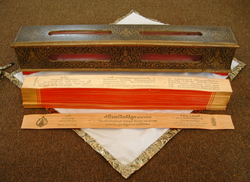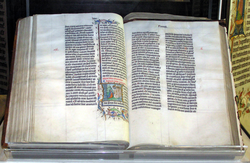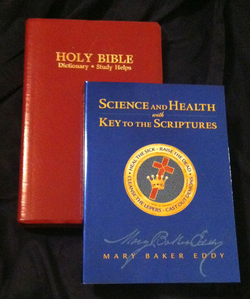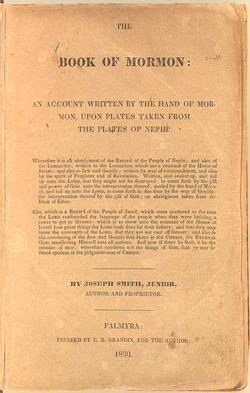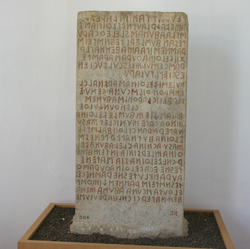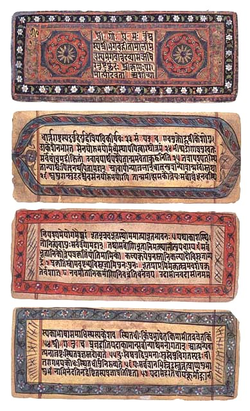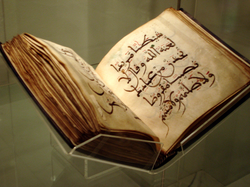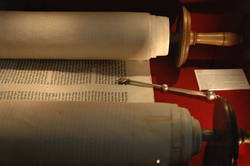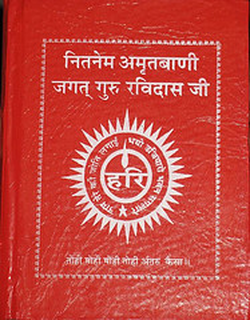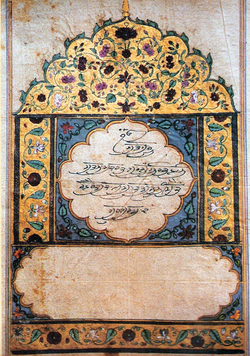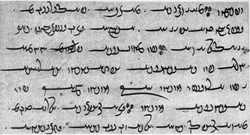Religious text
Religious text
Religious texts (also known as scripture, or scriptures, from the Latin scriptura, meaning "a writing") are texts which religious traditions consider to be central to their religious practice or set of beliefs. Religious texts may be used to provide meaning and purpose, evoke a deeper connection with the divine, convey religious truths, promote religious experience, foster communal identity, and guide individual and communal religious practice. Religious texts often communicate the practices or values of a religious traditions and can be looked to as a set of guiding principles which dictate physical, mental, spiritual, or historical elements considered important to a specific religion. The terms 'sacred' text and 'religious' text are not necessarily interchangeable in that some religious texts are believed to be sacred because of their nature as divinely or supernaturally revealed or inspired, whereas some religious texts are simply narratives pertaining to the general themes, practices, or important figures of the specific religion, and not necessarily considered sacred by itself. A core function of a religious text making it sacred is its ceremonial and liturgical role, particularly in relation to sacred time, the liturgical year, the divine efficacy and subsequent holy service; in a more general sense, its performance.
It is not possible to create an exhaustive list of religious texts, because there is no single definition of which texts are recognized as religious.
History of religious texts
One of the oldest known religious texts is the Kesh Temple Hymn of Ancient Sumer, a set of inscribed clay tablets which scholars typically date around 2600 BCE. [undefined] The Epic of Gilgamesh from Sumer, although only considered by some scholars as a religious text, has origins as early as 2150-2000 BCE, and stands as one of the earliest literary works that includes various mythological figures and themes of interaction with the divine. [undefined] The Rig Veda of ancient Hinduism is estimated to have been composed between 1700–1100 BCE, which not only denotes it as one of the oldest known religious texts, but also one of the oldest written religious text which is still actively used in religious practice to this day.
There are many possible dates given to the first writings which can be connected to Talmudic and Biblical traditions, the earliest of which is found in scribal documentation of the 8th century BCE, [undefined] followed by administrative documentation from temples of the 5th and 6th centuries BCE, [undefined] with another common date being the 2nd century BCE. [undefined] Although a significant text in the history of religious text because of its widespread use among religious denominations and its continued use throughout history, the texts of the Abrahamic traditions are a good example of the lack of certainty surrounding dates and definitions of religious texts.
High rates of mass production and distribution of religious texts did not begin until the invention of the printing press in 1440, [undefined] before which all religious texts were hand written copies, of which there were relatively limited quantities in circulation.
Associated terminology
A religious canon refers to the generally accepted, uniform, and often unchanging collection of texts which a religious denomination considers comprehensive in terms of their specific application of texts.
For example, the content of a Protestant Bible may differ from the content of a Catholic Bible- insofar as the Protestant Old Testament does not include the Deuterocanonical books while the Roman Catholic canon does. Protestants and Catholics use the same 27 book NT canon, as well as the same 39 book OT protocanon, also shared by Jews.
The word "canon" comes from the Sumerian word meaning "standard".
The terms "scripture" and variations such as "Holy Writ", "Holy Scripture" or "Sacred Scripture" are defined by the Oxford English Dictionary as terms which specifically apply to Biblical text and the Christian tradition. [undefined]
Hierographology (Ancient Greek: ἱερός, hieros, "sacred" or "holy"; γραφή, graphe, "writing"; λόγος, logos, "word" or "reason") (archaically also 'hierology') is the study of sacred texts.
Sacred texts of various religions
The following is an in-exhaustive list of links to specific religious texts which may be used for further, more in-depth study.
Adidam
The writings of Franklin Albert Jones a.k.a. Adi Da Love-Ananda Samraj Aletheon The Companions of the True Dawn Horse The Dawn Horse Testament Gnosticon The Heart of the Adi Dam Revelation Not-Two IS Peace Pneumaton Transcendental Realism
Aetherius Society
The Nine Freedoms
Ásatrú
Havamal
Eddur
Astronism
Omnidoxy
Atenism
Great Hymn to the Aten
Ayyavazhi
The Akilathirattu Ammanai
The Arul Nool
Aztec religion
The Borgia Group codices
Bahá'í Faith
Books by Bahá'u'lláh
The Four Valleys
The Seven Valleys
The Hidden Words of Bahá’u’lláh
The Hidden Words of Bahá’u’lláh
Gems of Divine Mysteries
The Book of Certitude
Summons of the Lord of Hosts
Tabernacle of Unity
Kitáb-i-Aqdas
Tablets of Bahá’u’lláh Revealed After the Kitáb-i-Aqdas
Epistle to the Son of the Wolf
Gleanings from the Writings of Bahá'u'lláh
Bön
Bon Kangyur and Tengyur
Buddhism
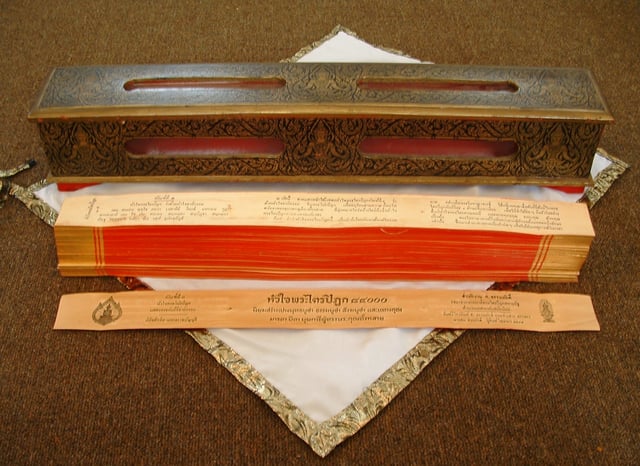
Ancient style of scripture used for the Pāli Canon
- TheravadaBuddhism
The Tipitaka or Pāli Canon Vinaya Pitaka Sutta Pitaka Digha Nikaya, the "long" discourses. Majjhima Nikaya, the "middle-length" discourses. Samyutta Nikaya, the "connected" discourses. Anguttara Nikaya, the "numerical" discourses. Khuddaka Nikaya, the "minor collection". Abhidhamma Pitaka
- East AsianMahayana
The Chinese Buddhist Mahayana sutras, including Diamond Sutra and the Heart Sutra Shurangama Sutra and its Shurangama Mantra Great Compassion Mantra Pure Land Buddhism Infinite Life Sutra Amitabha Sutra Contemplation Sutra other Pure Land Sutras Tiantai, Tendai, and Nichiren Lotus Sutra Shingon Mahavairocana Sutra Vajrasekhara Sutra
- Tibetan Buddhism
Tibetan Kangyur and Tengyur
Caodaism
Kinh Thiên Đạo Và Thế Đạo (Prayers of the Heavenly and the Earthly Way)
Pháp Chánh Truyền (The Religious Constitution of Caodaism)
Tân Luật (The Canonical Codes)
Thánh Ngôn Hiệp Tuyển (Compilation of Divine Messages) [undefined]
Cheondoism
The Donghak Scripture
The Songs of Yongdam
The Sermons of Master Haeweol
The Sermons of Revered Teacher Euiam [undefined]
Christianity

The Chinese Diamond Sutra, the oldest known dated printed book in the world, printed in the 9th year of Xiantong Era of the Tang Dynasty, or 868 CE. British Library.
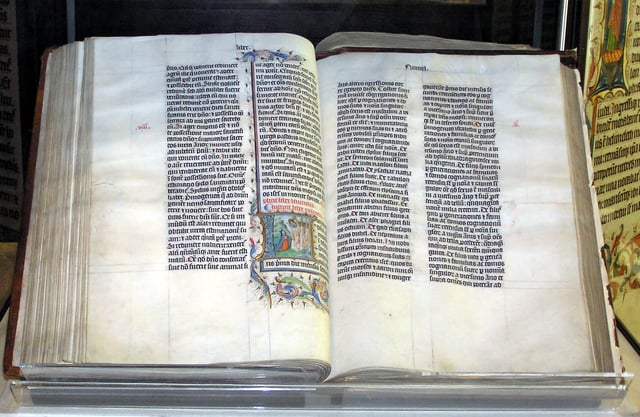
Christian Bible, 1407 handwritten copy
- Traditional Christianity
The Bible (the Old Testament and the New Testament). Some denominations also include the Apocrypha. For Protestantism , this is the 66-book canon - the Jewish Tanakh of 24 books divided differently (into 39 books) and the universal 27-book New Testament. Some denominations also include the 15 books of the Apocrypha between the Old Testament and the New Testament, for a total of 81 books. For Catholicism , this includes seven deuterocanonical books in the Old Testament for a total of 73 books, called the Canon of Trent (in versions of the Latin Vulgate, 3 Esdras and 4 Esdras are included in an appendix, but considered non-canonical). For the Eastern Orthodox Church , this includes the anagignoskomena , which consist of the Catholic deuterocanon, plus 3 Maccabees, Psalm 151, the Prayer of Manasseh, and 3 Esdras. 4 Maccabees is considered to be canonical by the Georgian Orthodox Church. The Ethiopian Orthodox Tewahedo Church (and its offspring, the Eritrean Orthodox Church) adds various additional books depending on the specific enumeration of the canon (see Ethiopian Biblical canon), but always includes 4 Esdras, the Book of Jubilees, 1 Enoch, 4 Baruch, and 1, 2, and 3 Meqabyan (no relation to the Books of Maccabees). Some Syriac churches accept the Letter of Baruch as scripture.
- Christian Scientists
The Bible
Science and Health with Key to the Scriptures by Mary Baker Eddy. This textbook, along with the Bible, serves as the permanent "impersonal pastor" of the church.
Nag Hammadi library and other Gnostic texts (not from the Bible)
Some books of the Old Testament and New Testament Cerdonianism and Marcionism
Only the Gospel of Marcion and selected Pauline epistles accepted
- Jehovah's Witnesses
The Bible (The New World Translation of the Holy Scriptures is their preferred translation.)
The Bible The Church of Jesus Christ of Latter-day Saints (LDS Church) uses the LDS edition of the King James Bible for English-speaking members; other versions are used in non-English speaking countries. The Community of Christ (RLDS) uses the Joseph Smith Translation, which it calls the Inspired Version, as well as updated modern translations.
The Book of Mormon
The Pearl of Great Price
The Doctrine and Covenants There are significant differences in content and section numbering between the Doctrine and Covenants used by the Community of Christ (RLDS) and the LDS Church.
Other, smaller branches of Latter Day Saints include other scriptures, such as the Book of the Law of the Lord used by the Church of Jesus Christ of Latter Day Saints (Strangite) or The Word of the Lord used by Fettingite branches.
- Native American Church(Christian-leaning factions)Seebelow.
- Rastafari movementSeebelow.
The Bible
The writings of Ellen White are held to an elevated status, though not equal with the Bible, as she is considered to have been an inspired prophetess.
- SwedenborgianismSeebelow.
- Unification ChurchSeebelow.
The Five Classics
The Four Books
The Thirteen Classics
The Three Commentaries
Discordianism
The Principia Discordia
Druidism
The Mabinogion
Lebor Gabála Érenn
Druze
Rasa'il al-hikmah
Ancient Egyptian religion
- Old Kingdom
Pyramid Texts
- First Intermediate Period and Middle Kingdom
Coffin Texts
- Second Intermediate Period
Book of the Dead
Book of Caverns
Book of Gates
Amduat
Book of the Heavenly Cow
Litany of Re
Etruscan religion
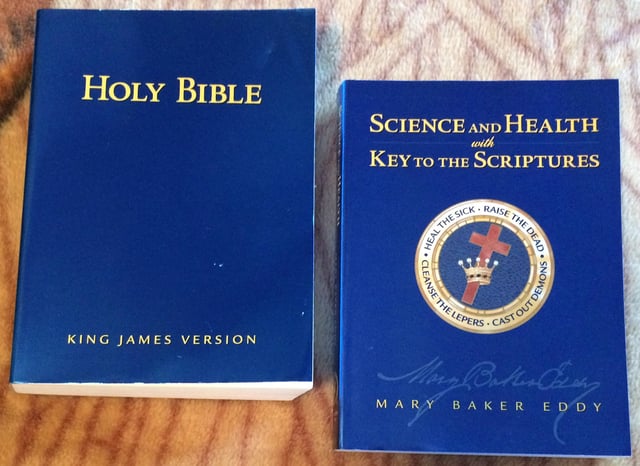
The Bible (left) and Science and Health with Key to the Scriptures (right) serve as the pastor of the Christian Science church.
Liber Linteus
Pyrgi Tablets
Theogony
Homeric Hymns
Iliad and Odyssey
The golden verses of Pythagoras
Hermeticism
Hermetica, Kybalion, Emerald Tablet and associated writings
Hinduism
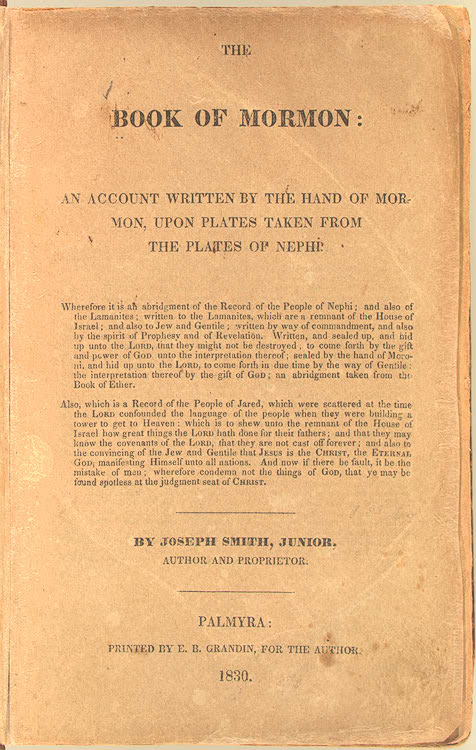
Cover page of The Book of Mormon from an original 1830 edition, by Joseph Smith, Jr. (Image from the U.S. Library of Congress Rare Book and Special Collections Division.)
- Śruti
Vedas Rig Veda Sama Veda Yajur Veda Atharva Veda
Brahmanas
Aranyakas
Upanishads
- Smriti
Itihāsas Mahābhārata (including the Bhagavad Gita) Bhagavad Gita Ramayana
Puranas (List) Bhagavata Purana
Tantras
Sutras (List)
Stotras
Ashtavakra Gita
Gherand Samhita
Gita Govinda
Hatha Yoga Pradipika
Yoga Vasistha
- InPurva Mimamsa
Purva Mimamsa Sutras
- InVedanta(Uttar Mimamsa)
Brahma Sutras of Vyasa
- InYoga
Yoga Sutras of Patanjali
- InSamkhya
Samkhya Sutras of Kapila
- InNyaya
Nyāya Sūtras of Gautama
- InVaisheshika
Vaisheshika Sutras of Kanada
- InVaishnavism
Vaikhanasa Samhitas
Pancaratra Samhitas
Divyaprabandam
- InSaktism
Sakta Tantras
- InKashmir Saivism
64 Bhairavagamas
28 Shaiva Agamas
Shiva Sutras of Vasugupta
Vijnana Bhairava Tantra
- InPashupata Shaivism
Pashupata Sutras of Lakulish
Panchartha-bhashya of Kaundinya (a commentary on the Pashupata Sutras)
Ganakarika
Ratnatika of Bhasarvajna
- InShaiva Siddhanta
28 Saiva Agamas
Tirumurai (canon of 12 works)
Meykandar Shastras (canon of 14 works)
- InGaudiya Vaishnavism
Brahma Samhita
Jayadeva's Gita Govinda
- Krishna-karnamrita
Chaitanya Bhagavata
Chaitanya Charitamrita
Prema-bhakti-candrika
Hari-bhakti-vilasa
- InLingayatism
Siddhanta Shikhamani
Vachana sahitya
Mantra Gopya
Shoonya Sampadane
28 Agamas
Karana Hasuge
Basava purana
- InKabir Panth
poems of Kabir
- InDadu Panth
poems of Dadu
Islam

Pyramid texts from Teti I's pyramid.
The Quran (also referred to as Kuran, Koran, Qur’ān, Coran or al-Qur’ān) – Four books considered to be revealed and mentioned by name in the Qur'an are the Quran (revealed to Muhammad), Tawrat (revealed to Musa), the Zabur (revealed to Dawud) and the Injil (revealed to Isa)
- Svetambara
11 Angas Secondary 12 Upangas, 4 Mula-sutras, 6 Cheda-sutras, 2 Culika-sutras, 10 Prakirnakas
- Digambara
Karmaprabhrita, also called Satkhandagama
Kashayaprabhrita
- Nonsectarian/Nonspecific
Jina Vijaya
Tattvartha Sutra
GandhaHasti Mahabhashya (authoritative and oldest commentary on the Tattvartha Sutra)
Judaism
- Rabbinic JudaismSee also:Rabbinic literature
The Tanakh i.e. Hebrew Bible Torah (teachings) Nevi'im (prophets) Ketuvim (writings)
The Talmud Mishnah Gemara
- Kabbalism
Kabbalah: Primary texts
Zohar
Early texts: Noam Elimelech (Elimelech of Lizhensk) Kedushat Levi (Levi Yitzchok of Berditchev)
Foundational texts of various Hasidic sects: Likutei Moharan (Breslov) Me'or Einayim (Chernobyl) Mei Hashiloach (Izhbitza – Radzin) Tanya (Chabad) Vayoel Moshe (Satmar)
- Karaite Judaism
The Tanakh
- Haymanot
The Tanakh with several Jewish apocrypha
Konkokyo
Konkokyo Kyōten (Sacred Scriptures of Konkokyo) Oshirase-Goto Obobe-Chō Konko Daijin Oboegaki Gorikai I Gorikai II Gorikai III [undefined]
Mandaeanism
The Ginza Rba
Book of the Zodiac
Qolusta, Canonical Prayerbook
Book of John the Baptizer
Diwan Abatur, Purgatories
1012 Questions
Coronation of Shislam Rba
Baptism of Hibil Ziwa
Haran Gawaita
The Evangelion (Greek: Εὐαγγέλιον, meaning roughly "good news"). Also known as the Gospel of Mani and The Living Gospel
the Treasure of Life
the Pragmateia (Greek: πραγματεία)
the Book of Mysteries
The Book of Giants
the Epistles
the Psalms and Prayers.
A Coptic Manichaean Psalter, discovered in Egypt in the early 1900s, was edited and published by Charles Allberry from Manichaean manuscripts in the Chester Beatty collection and in the Berlin Academy, 1938–9.
The Shabuhragan
The Arzhang
The Kephalaia (Greek: Κεφάλαια), "Discourses", found in Coptic translation.
Maya religion
The Popol Vuh
the Dresden Codex
the Madrid Codex
the Paris Codex
countless destroyed codices
Meher Baba
God Speaks
Discourses
Native American Church
The Bible (among Christian-leaning factions only)
New Age religions
Various New Age religions may regard any of the following texts as inspired:
A Course in Miracles
Conversations with God
Oahspe
The Urantia Book
Isis Unveiled
Orphism
Orphic Poems
Raëlism
The writings of Raël aka Claude Vorilhon Intelligent Design: Message from the Designers Sensual Meditation Yes to Human Cloning
Rastafari movement
The Bible (Ethiopian Orthodox canon)
the Holy Piby
the Kebra Nagast
The speeches and writings of Haile Selassie I (including his autobiography My Life and Ethiopia's Progress)
Royal Parchment Scroll of Black Supremacy
Ravidassia
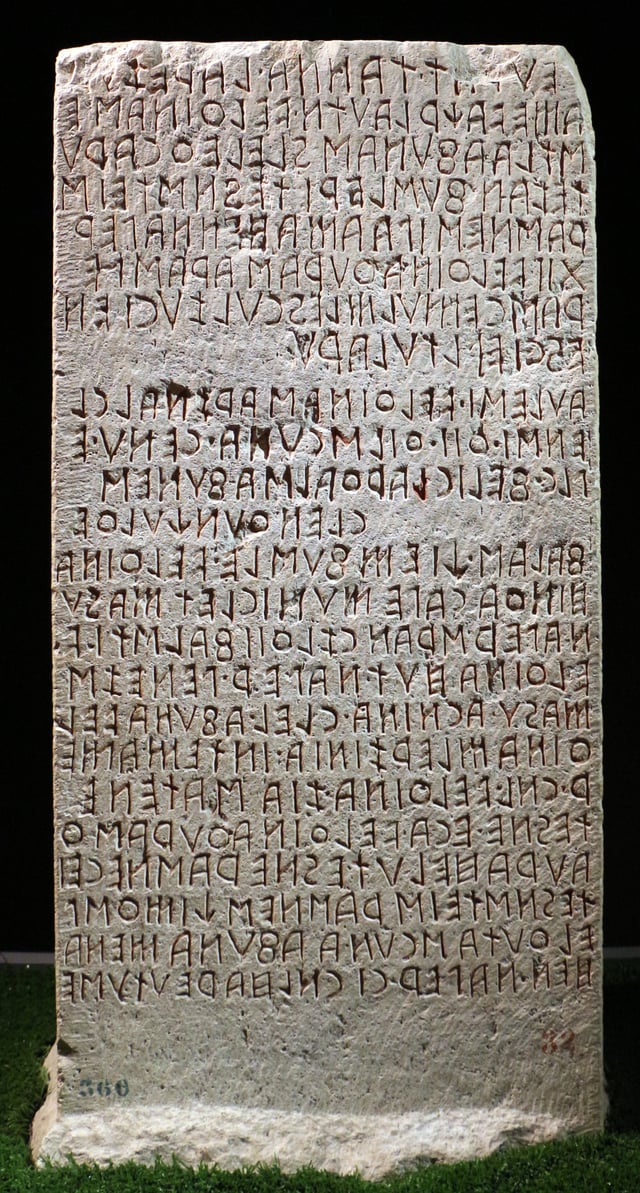
The Cippus of Perugia, 3rd or 2nd century BCE
The Amritbani Guru Ravidass Ji
Samaritanism
The Samaritan Torah
Satanism
The Satanic Bible
The Satanic Rituals
Science of Mind
The Science of Mind
Dianetics: The Modern Science of Mental Health
List of Scientology texts
The Kojiki
The Rikkokushi, which includes the Nihon Shoki and the Shoku Nihongi
The Fudoki
The Jinnō Shōtōki
The Kujiki
Sikhism
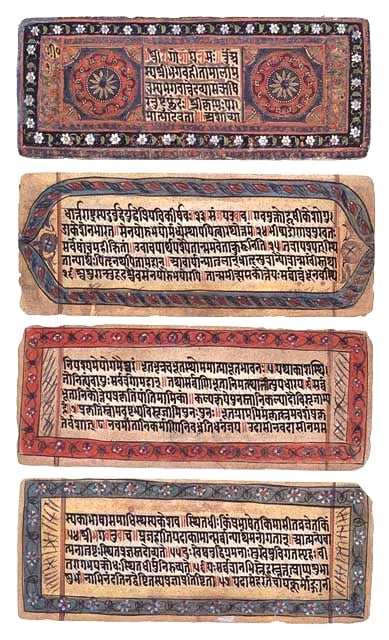
The Bhagavad Gita is Lord Krishna's counsel to Arjuna on the battlefield of the Kurukshetra.
The Guru Granth Sahib
The Dasam Granth
Spiritism
The Spirits Book
The Book on Mediums
The Gospel According to Spiritism
Heaven and Hell
The Genesis According to Spiritism
Sumerian
The Barton Cylinder
Swedenborgianism
- The New Church
The Bible (several books omitted)
The works of Emanuel Swedenborg (not considered equal to the Bible)
- TheGeneral Church
The Bible (several books omitted)
The works of Emanuel Swedenborg (considered equal to the Bible)
Tao Te Ching
Zhuangzi (book)
Daozang
Tenrikyo
The Ofudesaki
The Mikagura-uta
The Osashizu
The Holy Books of Thelema, especially The Book of the Law
Unarius Academy of Science
The Voice of Venus
Unification Church
The Divine Principle
The Bible as illuminated by more recent revelation
Urantianism
The Urantia Book
Wicca
Book of Shadows
Charge of the Goddess
Threefold Law
Wiccan Rede
Yârsân
Kalâm-e Saranjâm
Yazidi
Yazidi Black Book
Yazidi Book of Revelation
The true core texts of the Yazidi religion that exist today are the hymns, known as qawls.
Yorùbá
Odù Ifá
Jaap Verduijn's Odu Ifa Collection
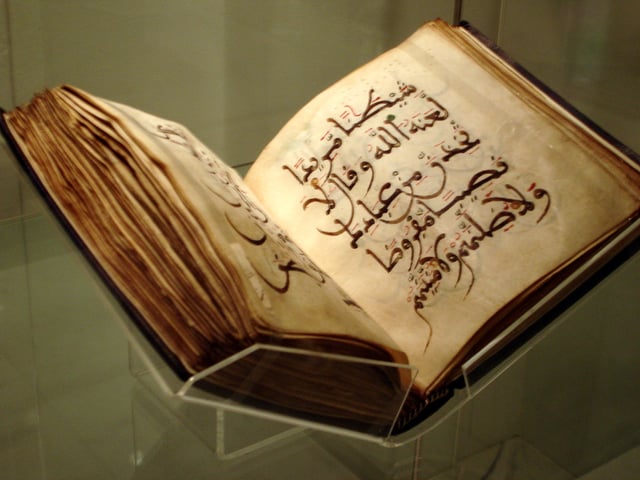
11th Century North African Qur'an in the British Museum
Primary religious texts, that is, the Avesta collection: The Yasna , the primary liturgical collection, includes the Gathas . The Visperad , a collection of supplements to the Yasna. The Yashts , hymns in honor of the divinities. The Vendidad , describes the various forms of evil spirits and ways to confound them. shorter texts and prayers, the Yashts the five Nyaishes ("worship, praise"), the Sirozeh and the Afringans (blessings).
There are some 60 secondary religious texts, none of which are considered scripture.
The most important of these are: The Denkard (middle Persian, 'Acts of Religion'), The Bundahishn , (middle Persian, 'Primordial Creation') The Menog-i Khrad , (middle Persian, 'Spirit of Wisdom') The Arda Viraf Namak (middle Persian, 'The Book of Arda Viraf') The Sad-dar (modern Persian, 'Hundred Doors', or 'Hundred Chapters') The Rivayats, 15th-18th century correspondence on religious issues
For general use by the laity: The Zend (lit. commentaries), various commentaries on and translations of the Avesta. The Khordeh Avesta
